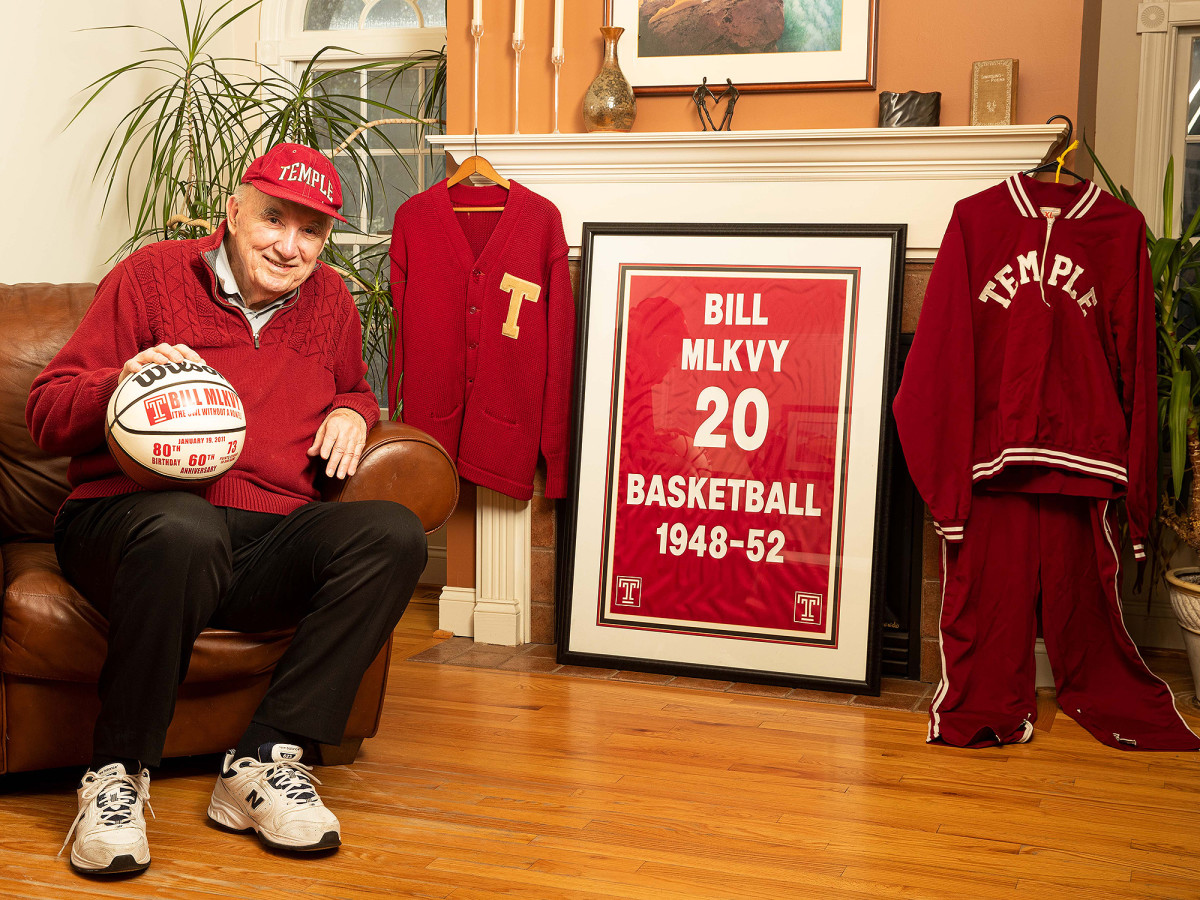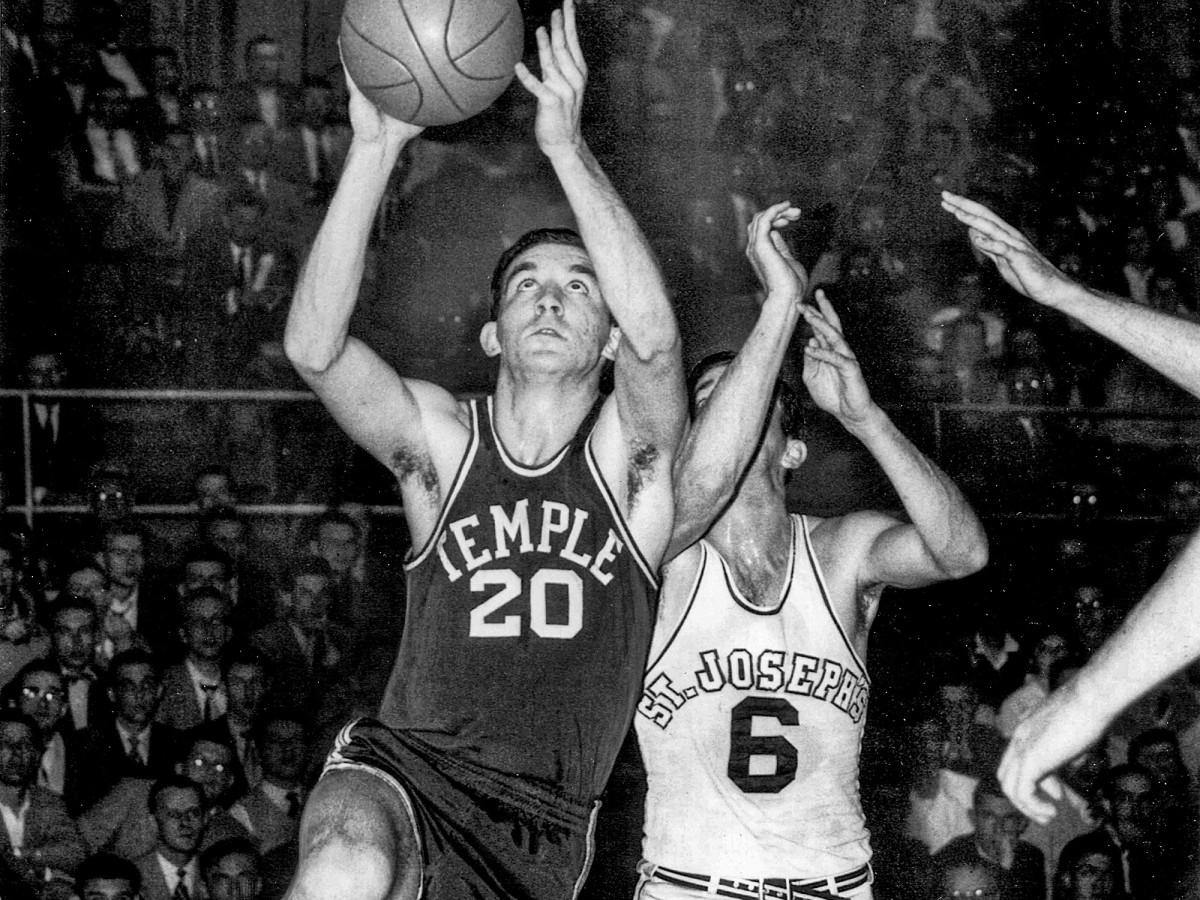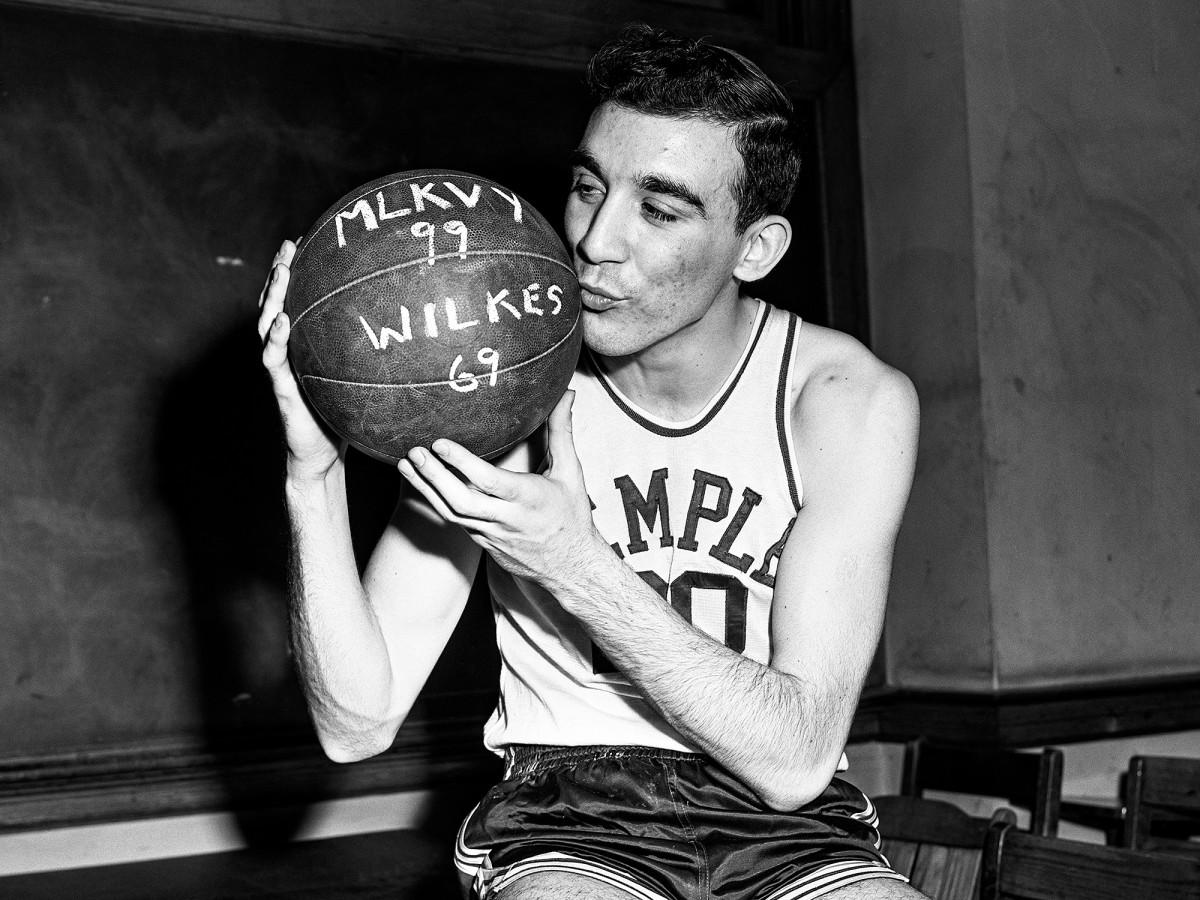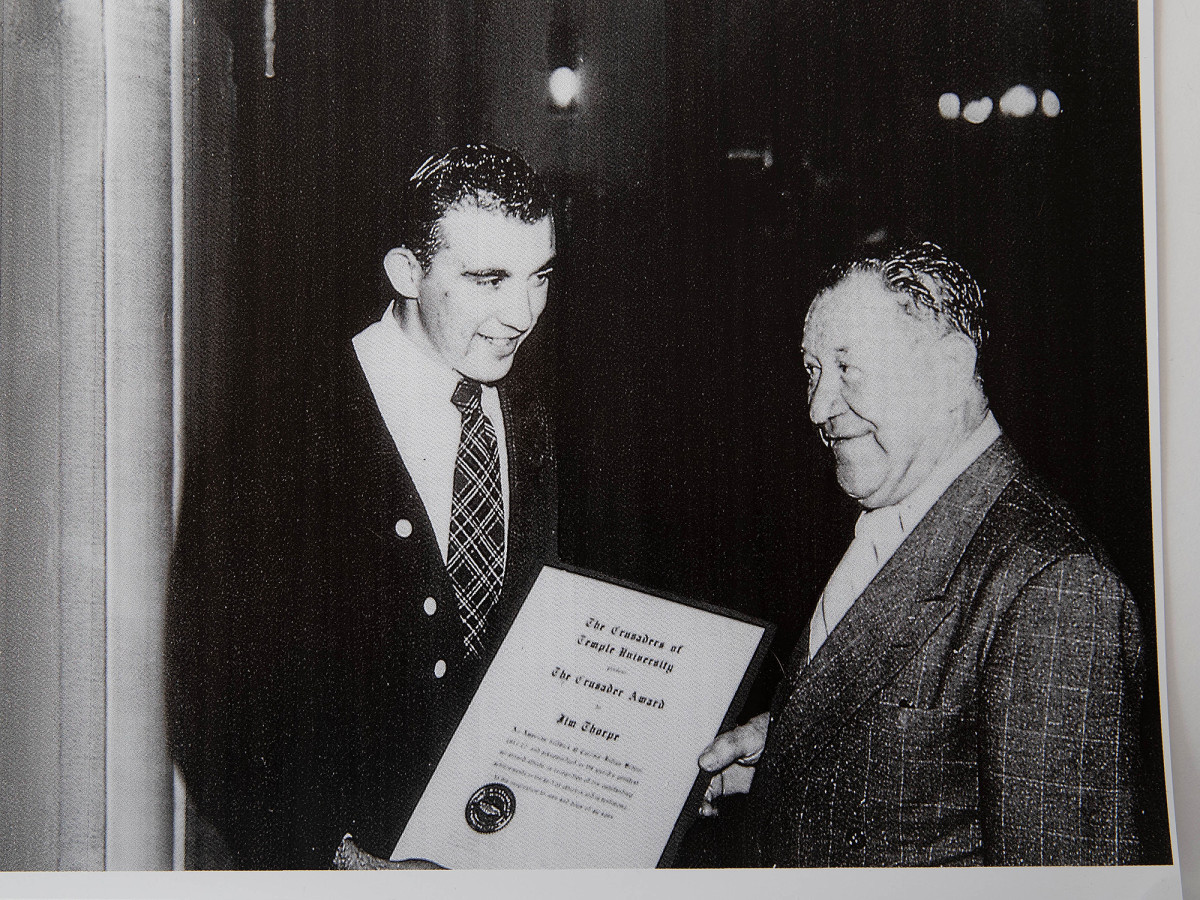This Future Dentist Once Dropped 54 Straight. Then He Was Lost to Time
Even in his 90th year, the old man’s shoulders stretch as broad as the Allegheny range. The long-ago Temple All-America no longer stands 6' 4", but he remains a looming presence, in person and in the NCAA basketball record book. Back on campus in North Philadelphia, he draws a visitor close and flashes a silver lapel pin affixed to his black sports coat, inscribed with his alma mater’s familiar, serifed T. “Legends Club,” he says with unfettered pride. “That’s for $100,000 donors.”
He inscribed his legend for the Cherry and White long before he ever wrote Temple a check, but his legend concerns all of college basketball. On March 3, 1951, he set a Division I record that will leave you absolutely incredulous, not only because of its obscure nature but also because it still exists. It is, in fact, the oldest extant individual record in D-I hoops.* And it belongs to Bill Mlkvy.
Who?
Mlkvy.
Whooo?
The Owl Without a Vowel.

Nearly seven decades since Mlkvy last suited up for Temple, what has survived more so than his virtuoso performance is that sublime nom de guerre. It is damn near perfect: a pseudonym that denotes his individuality while also being mellifluous. It rhymes. It’s whimsical. The Owl Without a Vowel.
“Ralph Bernstein was doing a story on me for Sport magazine,” says Mlkvy, whose father emigrated to the U.S. from Czechoslovakia in 1905. “Bernstein pecked at the typewriter. ‘This name is nuts,’ he said. ‘It’s tyranny with two fingers.’”
And then suddenly, like Archimedes sitting up in the tub, Bernstein had his Eureka! moment. The Owl Without a Vowel. “Years earlier, my brothers and I had approached my father and asked him to change the family name,” says Mlkvy (pronounced MILK-vee). “I guess we didn’t like that it looked strange. But my dad wouldn’t hear of it. I’m grateful to my parents for not listening to us.”
In late February 1951, the Owls, under the guidance of coach Josh Cody, a former All-America football player at Vanderbilt, were shuffling toward a .500 finish. Mlkvy, then 20 and a junior on the basketball court, was already in his first year of dental school at Temple. College sports, excluding football, were practically in prehistoric times. The Owls practiced in a tiny gym on the ninth floor of Conwell Hall, an administration building on Broad Street. They played off-campus at Convention Hall, a few miles south, adjacent to the University of Pennsylvania. Players were expected to get themselves to games.
“We’d take the subway, until a few of us figured out that if we each chipped in a dollar, five of us could get a cab to [a game],” Mlkvy says. “One night it was raining hard. We had a big game, and there were no taxis. What do we do?
“Then we looked at Tommy Deegan—he was our 10th man,” Mlkvy says, beginning to chuckle. “ ‘Tommy, you have to throw yourself onto the hood of a cab. For the team.’ And then someone … well, someone pushed him.”
Deegan flew onto the hood of a taxi (block or charge?), and the cabbie stopped. The Owls talked themselves into the vehicle. Deegan was not seriously injured, but Mlkvy says he does remember “Tommy was limping during warmups.”
There was no television coverage back then. No bracketology. No internet. Mlkvy, meanwhile, was engrossed in his dental anatomy coursework, leaving him oblivious to his hardwood stature. “I remember,” he says, “someone stopping me on the street and asking, ‘Bill, do you realize you’re leading the nation in scoring?’ I had no idea.”

If Mlkvy did not assiduously track his stats, he never doubted his prowess. Arriving on the Broad Street campus in the summer of 1948, he had assured Cody he could play all five positions. As for shooting range? During a game against La Salle, Mlkvy caught the opening tip and launched a shot from half court. It sailed over the backboard. “Coach looked at me,” he recalls, “and asked, ‘You O.K., Bill?’”
He had plenty of positives to offset that, and in 1950–51 he finished the season not only leading the nation in scoring (29.2 points per game) but also second in both rebounds (18.9) and assists (7.0)—all stats he insists he was ignorant of until after the Owls’ 12-13 campaign ended.
But first he and the Owls bused two hours north to Wilkes-Barre, Pa., on Saturday, March 3, 1951, to place a bow on a lackluster season. Wilkes College, not a Division I school, presented Mlkvy with an opportunity to play in front of his sister, Lillian, then a student at nearby Bloomsburg State Teachers College. According to Mlkvy, Lillian organized a busload of students to come watch her brother play. Among them: a senior on Bloomsburg’s own basketball team named Chuck Daly.
If true, the future Hall of Fame coach (now dead) bore witness to an indelible basketball moment, as Mlkvy scored 54 unanswered points for Temple—no teammate sunk so much as a free throw in between—establishing an NCAA record that holds to this day. The Owls won 99-69 that night, but on paper the visiting small forward could have done it alone, having personally outscored the Colonels 73-69. (His is the fourth-greatest scoring feat in Division I annals against any opponent; the record against a D-I foe is 72, by Kevin Bradshaw of U.S. International, in 1991).
Mlkvy beams at the memory. He recalls the evening vividly. “It was that one time—that one time in life,” he says, “when everything worked perfectly.”
Still. Fifty-four points in a row by one player? How does that happen? “I could shoot,” Mlkvy says. “They”—meaning his Owl teammates—“couldn’t shoot.” (Remember: 12-13, even with the nation’s leading scorer.)
During a timeout in the first half, Temple guard Roger White recognized that his All-America teammate was unguardable. “Listen,” White said in the huddle. “This is Bill’s night.” Soon after, Mlkvy embarked on his unfathomable spree.
The Owls’ best low-post player, he scored from the pivot. The team’s best ballhandler, he scored off the drive. Arguably the country’s best shooter, he scored from long range, deploying his favorite weapon, the two-handed set shot. “I could play all the positions,” Mlkvy says, “and I could shoot lefty or righty close to the basket. ... I had four Wilkes defenders around me on some plays.
“It didn’t matter.”
* * *

Mlkvy’s hometown of Palmerton is located in the heart of Pennsylvania’s coal region, and during his childhood the economy there revolved entirely around a zinc-smelting plant owned by the borough’s namesake, Stephen S. Palmer. It was a true-to-life version of Bedford Falls, the setting for It’s a Wonderful Life. Mlkvy’s childhood overlapped with that era.
“I started playing basketball at four,” he says, “and I can’t tell you how hard I worked at it.”
An older brother—one of his seven siblings—would blindfold young Bill and have him shoot from different spots on the court. From that exercise he learned a ball was shot with one’s entire body, not just arms and fingers. The basket at the local park, meanwhile, had no net. “I’d been playing for about four years before I joined a team and we played on a basket with a net,” Mlkvy remembers. “Coach,” he asked, “what are those white strings?”
“You’re gonna like this,” the coach replied.
Years later, Mlkvy’s 54 unanswered went nearly unnoticed in the moment. To his (or Temple’s) knowledge, there remains no box score from the game. No film. The following Monday’s issue of the Temple News student newspaper did take note of the 73-point scoring inferno, but it failed to mention Mlkvy’s historic scoring streak.
He did make it onto the broadsheet’s front page, but that news was unrelated to the game. The headline, an indicator that the Owl Without a Vowel was indeed a campus celebrity, read: BILL MLKVY’S PEN IS REPORTED LOST. (The writing instrument had been a gift a week earlier, at Bill Mlkvy Night, during the final home contest of the season.)
Ultimately, Mlkvy’s magic moment would be the highlight of a storied but truncated athletic career. As a senior he again led the Owls in scoring (17.8 ppg) and rebounding (15.8), but those relatively modest numbers revealed a player who’d become increasingly consumed by dental school. “I’d dress up for games having just extracted a tooth a few hours earlier,” Mlkvy says. “My mind was on my patients.”
And it would show. In the NBA draft that April, Mlkvy was selected first with a territorial pick by the Philadelphia Warriors, but he would play only one season, missing numerous games due to academic obligations. The following year, with the Korean War in full swing, he was advised that if he stayed in the NBA he would be susceptible to the military draft and conscripted as infantry. (He had already lost an older brother, Milton, in World War II.) If he remained in dental school, though, he would eventually enter the military as an officer. Which made for an easy choice: Mlkvy added even more consonants (D.D.S.) to the end of his name and practiced dentistry for a quarter century before retiring.

Sixty-nine years since a man of no vowels put together a streak of great consequence, Mlkvy’s record survives entirely without fanfare. His is an achievement that seems to have been lost to time, not unlike his pen. Yes, his retired number hangs from the rafters of Temple’s Liacouras Center; and, yes, hoops die-hards may betray a hint of recognition at the wondrous nickname. But as for the 54-point run? Mlkvy says it never comes up. “No one asks about it,” he says.
One day shy of the 11th anniversary of Mlkvy’s feat, about 125 miles south in Hershey, Pa., a 25-year-old Wilton Norman Chamberlain would score 100 points in a game for those same Warriors. It was, like Mlkvy’s mark, a monumental scoring feat that no one has ever come close to toppling. But was Wilt’s famous feat really all that much more impressive?
Chamberlain’s was “an incredible achievement,” the Owl Without a Vowel acknowledges. “But how many more minutes longer is an NBA game? (Eight.) And I wonder how many of my baskets would be three-pointers today.
“I think I might’ve come close.”
*One record older than Mlkvy’s—by 16 days—exists in the NCAA record book, but it’s not much of an achievement. On Feb. 17, 1951, Washington and Lee’s Jay Handlan took a record 71 shots against Furman. He made 30.
